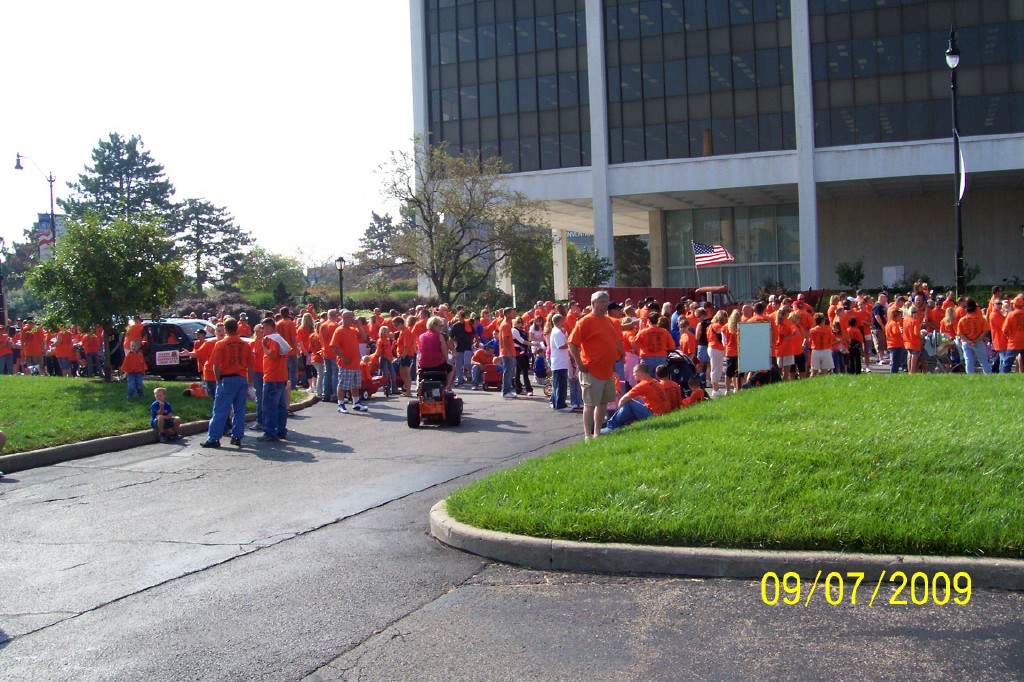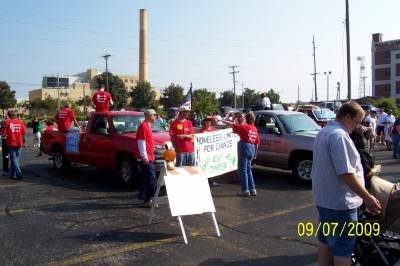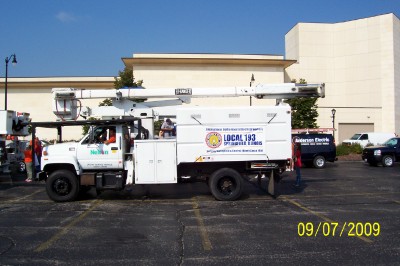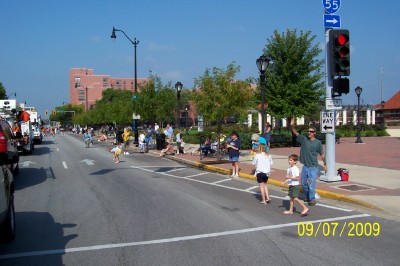It’s Jam Band Friday – hurray
( http://www.youtube.com/watch?v=x4KmbUCwkyE )
http://www.google.com/hostednews/ap/article/ALeqM5ioaMTqBpfb3mR-M1Vew-FC32oyqQD9B2FK880
Massive Texas wind farm operating
By JOHN McFARLAND (AP) – 20 hours ago
DALLAS — The world’s largest wind farm officially got up and running Thursday, with all 627 towering wind turbines churning out electricity across 100,000 acres of West Texas farmland.
The Roscoe Wind Complex, which began construction in 2007 and sprawls across four counties near Roscoe, is generating its full capacity of 781.5 megawatts, enough to power 230,000 homes, the German company E.ON Climate and Renewables North America said.
“This is truly sign milestone for us,” said Patrick Woodson, the company’s chief development officer. “In three years to be able to take this project from cotton fields to the biggest wind farm in the world is something we’re very proud of.”
The complex is about 220 miles west of Dallas and 300 miles south of the land where billionaire oilman T. Boone Pickens had planned an even larger wind farm before he scrapped the idea in July.
Texas leads the nation in wind power production, and this wind farm tops the capacity record of 735.5 megawatts set by another West Texas farm southwest of Abilene.
Renewable energy makes up a small fraction of the electricity grid, but the wind and solar sectors were among the fastest growing in the U.S. before the recession. Wind power in Texas has grown again this year but has slowed from the 2008 rate.
“We are expecting ’09 to be a somewhat smaller year overall, but still a fairly solid year,” said Kathy Belyeu of the American Wind Energy Association.
:}
( http://www.youtube.com/watch?v=rfU6kbgR1SY&NR=1 )
You can tell that wind is here to stay.
http://www.bloomberg.com/apps/news?pid=20601081&sid=aTWyaCoFJz5s
FPL to Buy 3 Wind Power Farms From Babcock & Brown (Update2)
By Katarzyna Klimasinska
Oct. 1 (Bloomberg) — FPL Group Inc., the biggest U.S. producer of wind and solar power, agreed to buy three wind farms from Babcock & Brown for $352 million.
The turbines, located in Texas, Wisconsin and South Dakota, have combined capacity of 184.5 megawatts, FPL’s NextEra Energy Resources LLC subsidiary said today in a statement. More than 80 percent of the output is sold under long-term contracts.
Juno Beach, Florida-based FPL will need approvals from the Federal Energy Regulatory Commission and the U.S. Justice Department to complete the transaction, which is scheduled to close by the end of this year. The wind farms will add to FPL’s 2010 earnings, according to the statement.
NextEra said the purchase includes a 79.5-megawatt wind farm in Carson County, Texas, northeast of Amarillo; a 54- megawatt development in Dodge County, Wisconsin, northwest of Milwaukee; and a 51-megawatt farm in Jerauld County, South Dakota, south of Wessington Springs.
FPL fell $1.48, or 2.7 percent, to $53.75 in New York Stock Exchange composite trading. The stock had climbed 9.7 percent this year before today:}
:}
( http://www.youtube.com/watch?v=zxGpmp6URuk&feature=related )
I love that quote:
|
There is plenty of wind out there and plenty of energy to be tapped. It’s just like an oil field that doesn’t run out. Tom Gray, AWEA
|
Oh sorry I was busy boogying
http://www.seco.cpa.state.tx.us/re_wind.htm
For the past two years, Texas has been the top wind producer in the United States, with over 3,953 wind-generated megawatts (MW) installed. Texas is also the first state to achieve the milestone of one Gigawatt of wind installations in a single year (2007). The demand for additional wind power has grown so rapidly that the Texas electric transmission grid has a critical need for expansion. In July 2007, the Texas Public Utility Commission announced its approval for additional transmission lines that could deliver as much as 25,000 megawatts of wind energy from remote areas in the state to urban centers by 2012, depending on how many wind farms are built. New transmission infrastructure will allow all Texans to access the the state’s vast wind resources.
DOE’s Energy Information Administration (EIA) reports that wind power is the fastest growing renewable energy technology, growing by 45% in 2006 due to strong demand, investment of private capital, and the support of federal and state governments. Electric utilities have shown an increased interest in wind project ownership, and wind industry sales to power marketers have become more common. Wind power has consistently remained at or below the average price of conventional electricity such as coal, nuclear, and natural gas.
AWEA has determined that two-thirds of the predicted growth of wind energy generation in the U.S. will occur in Texas, as three of the five largest wind farms in the nation are located in Texas. Texas already holds the record for the world’s largest wind farm, Horse Hollow Wind Energy Center, which was completed by FPL Energy, Inc. in late 2006. It also is the site for the nation’s second-largest wind farm, the 504.8-megawatt Sweetwater wind project, the fourth phase of which attained commercial operation in May, 2007.
The Horse Hollow Wind Energy Center in Texas remains the largest wind farm in the world with a total capacity of 735 megawatts (MW) spread across approximately 47,000 acres in Taylor and Nolan counties near Abilene in west central Texas.
The wind plant consists of 291 1.5-MW wind turbines from General Electric and 130 2.3-MW wind turbines from Siemens.
One MW is enough electricity to serve 250 to 300 homes on average each day
:}
( http://www.youtube.com/watch?v=359QibQrD1Q&feature=related )
I love it when a plan comes together.
http://www.infinitepower.org/projects.htm
|
Texas Renewable Energy Projects
|
 |
This page presents information on notable renewable energy projects around the state, representing the major renewable energy technologies.
The following is a list of Texas State Energy Conservation Office (SECO) renewable energy projects:
| Wind Power Projects |
|
| Delaware Mountain Wind Farm |
 |
| Owner: |
American National Wind Power |
| Size: |
30 MW |
| Location: |
Culberson County, Texas |
| Installed: |
1999 |
|
American National Wind Power is a subsidiary of National Wind Power. This wind farm is National Wind Power’s (NWP) first project in Texas and is located in Culberson County, northeast of the town of Van Horn in West Texas. The ranch on which it is built is used for raising cattle and deer and is also the site of the West Texas Wind Farm Power Project, described below. Given the right legislative environment, NWP plan to develop it to a full potential of 250MW. The power produced by the Delaware Mountain Wind Farm is purchased by the Lower Colorado River Authority (Austin, Texas) and Reliant Energy HL&P (Houston, Texas) for distribution to their customers.
|
|
| Texas Wind Power Project |

|
| Owner: |
General Land Office & Lower Colorado River Authority |
| Size: |
35 MW |
| Location: |
Culberson County, Texas |
| Installed: |
1995 |
| The Lower Colorado River Authority (LCRA) teamed with the General Land Office GLO) and private industry to develop this commercial wind power plant, the first in Texas. The Texas Wind Power Project, located in Culberson County in West Texas, has 112 Kenetech 33M-VS wind turbines capable of generating 35 megawatts of electricity — enough to power 12,000 to 15,000 homes. Since the ribbon-cutting for the Texas Wind Power Project in 1995, the Texas’ Permanent School Fund earned more than $750.000 from it. The project is expected to earn more than $3 million for the PSF and create $300 million in increased economic activity over the 25-year lease period. For additional information see this GLO web page. |
:}
God bless Texas and Ry Cooder
( http://www.youtube.com/watch?v=LXx0qrasdTE&feature=related )
:}






 Welcome to our free online resource for off-grid living.
Welcome to our free online resource for off-grid living.

 In the summer of 1980, my wife, three-month old son and I moved “off-grid”. We loved living in San Francisco but wanted to live a simpler, more independent lifestyle, and so we bought a small cabin with land on a rural island in the Pacific Northwest. Since there were no services to the island, our home had no electricity. Residents of the island had to create their own electricity or do without.
In the summer of 1980, my wife, three-month old son and I moved “off-grid”. We loved living in San Francisco but wanted to live a simpler, more independent lifestyle, and so we bought a small cabin with land on a rural island in the Pacific Northwest. Since there were no services to the island, our home had no electricity. Residents of the island had to create their own electricity or do without.







